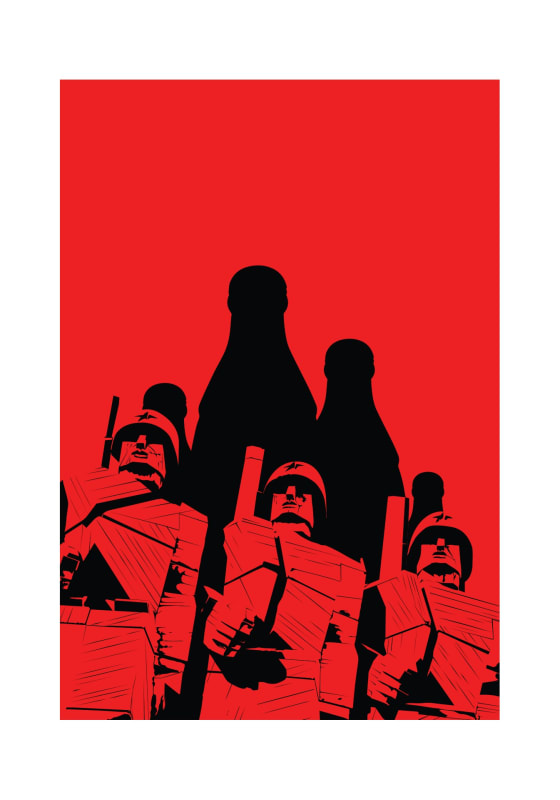CONSUMERISM
AZÚCAR HIERRO CAFEÍNA by Fabio Castro
Fabio Castro Pellizzari AKA F*Castro is a visual artist who dwells between pop culture, science and technology. He was born in March 1976 in Santiago, Chile, leaving the following year with his parents into exile in the United States. He first arrived in Iowa and then moved to Silicon Valley in San Jose, California, where he lived until 1983 when his family returned to Chile. Here, in Chile, he completed his high school studies and, in 1995, enrolled in the Universidad de Chile's Faculty of Arts, graduating in 1999. His professional interests led him to relocate to Barcelona in 2005, the city in which he remained until 2015 and where he developed his work and research on different media and techniques, from traditional casting to digital fabrication, installation, animation, video mapping, web and electronic programming, and 3D modelling. During this time, Fabio began creating and producing the pieces presented in this exhibition, ironically and trans-disciplinarily installing questions about the environment, power and contemporary politics.
Azúcar Hierro Cafeína [Sugar Iron Caffeine] is a series of artworks that inevitably refer to his family biography and, therefore, to his politics, as the artist is a "returnee" who breaks with the traditional patterns of the leftist culture of the Chilean 1973 diaspora. Being a Chilean exile from a country he does not know, and his education in the United States, but in a mestizo, multicultural and computerised enclave, such as Silicon Valley during its boom in the late 1970s and 1980s, come together in Fabio Castro. "Not belonging" became a discomfort and a driving force for research into visual languages and technological appropriations during his early years as an artist. Hence his displacement towards different media and horizons, in which his long stay in Catalonia, far from his roots, allowed him to articulate projects he would develop over the last decade.
This imagery presents contamination or mutation of the great political-economic narratives of the 20th century in the sarcastic confrontation of communism vs capitalism. The traditional
postmo quote intertwines Russian constructivism and its antagonistic socialist realism, taking on cruel overtones in the forced crossing with graphic icons of capitalism, whether they come from pop art or, unabashedly, the crudest American culture. Thus, it is that, at a table in a lost bar in Barcelona's Raval, the fortuitous encounter of El Lissitzky, with his red wedge beating the Tsarist whites, with the empanadas and red wine of the failed Chilean socialist revolution and the Warhol blessing of the capitalist nectar takes place: "You can be watching TV and see Coca-Cola, and you can know that the President drinks Coke, Liz Taylor drinks Coke, and just think, you can drink Coke, too. A Coke is a Coke, and no amount of money can get you a better Coke than the one the bum on the corner is drinking. All the Cokes are the same and all the Cokes are good. Liz Taylor knows it, the President knows it, the bum knows it, and you know it".
[1] In this transcultural wasteland, the Berlin Wall has fallen and hordes of
ossis[2] from the East have crossed the ruins of the old regime, heading with their arms open towards neoliberal capitalism, the globalisation of culture, McDonald's Happy Meals, the consumption of psychopharmaceuticals and mass tourism to the beat of the techno-pop sound of
Go West (re-recorded by the British duo Pet Shop Boys).
In these artworks, the past practice of agitprop (Bolshevik agitation propaganda) is brutally united with gringo merchandising through mechanical processes such as silkscreen printing, 3D sculptural printing and digital animation, unifying, standardising and de-ideologising iconographies adverse to Western culture. These are pieces whose dialectic is fulfilled not by fashion or deconstructive strategies derived from postmodernity, but by the ethos and catharsis of the artist.
Azúcar Hierro Cafeína is not only the appropriation of the Coca-Cola logo but also the metastasis of the market on the spoils of the USSR empire rather than the utopia of an egalitarian society that never existed. Communism turned into consumerism.
Raúl Miranda, artist and scenic researcher.
September 2022.
[1] Warhol, A. (1975). The Philosophy of Andy Warhol (From A to B & Back Again). New York: Harcourt Brace Jovanovich.
[2] Ossis: Citizens of the former German Democratic Republic.

